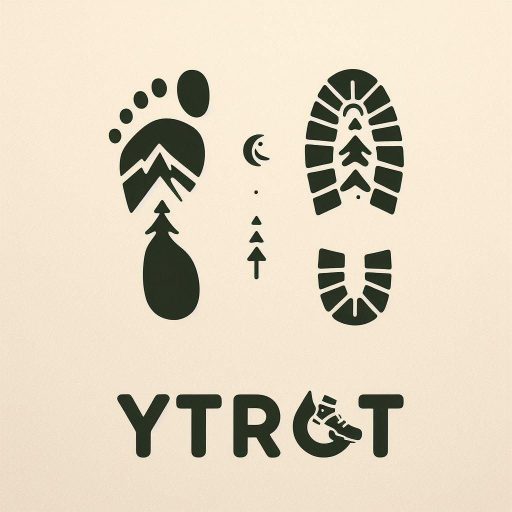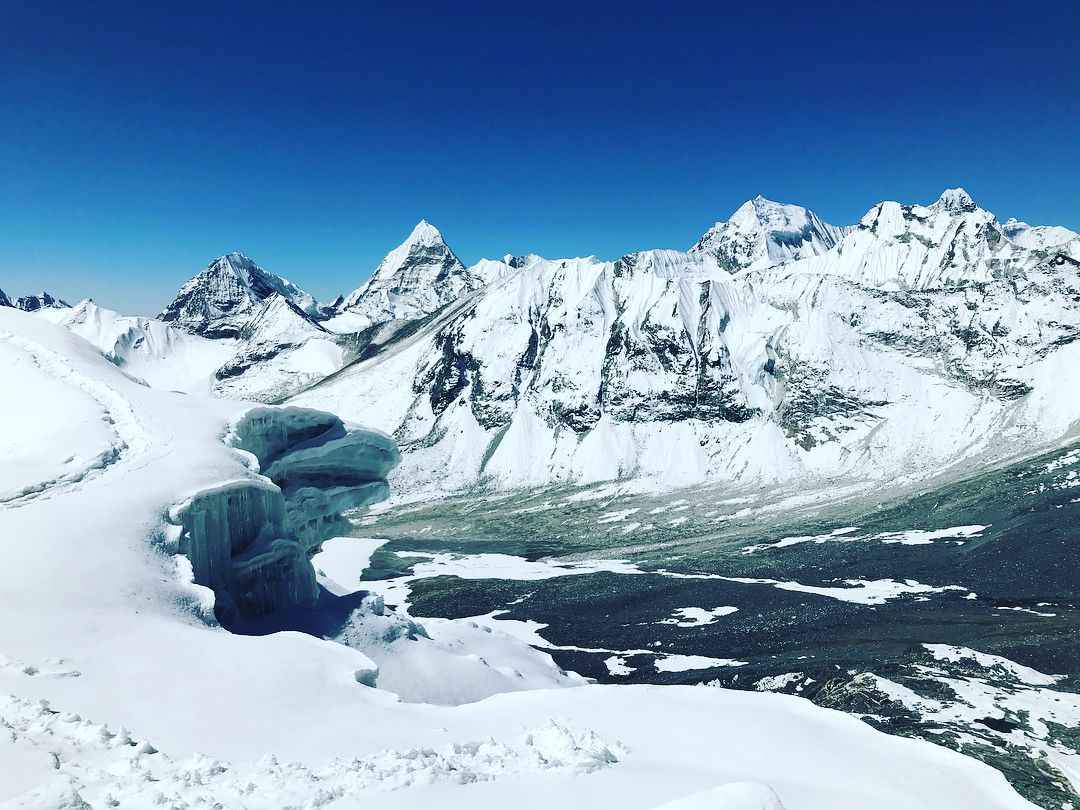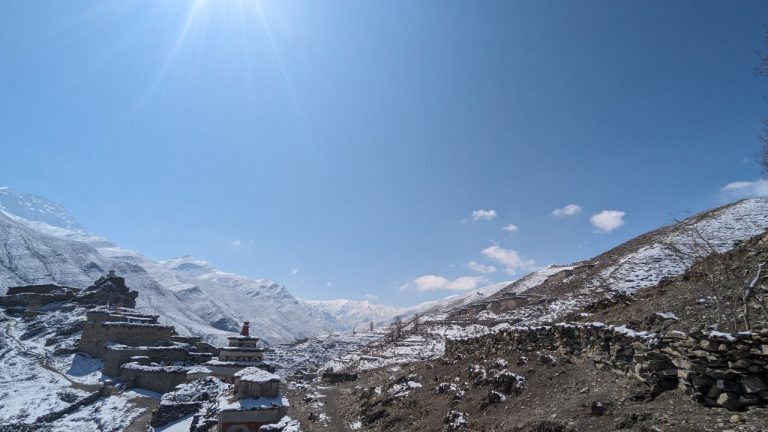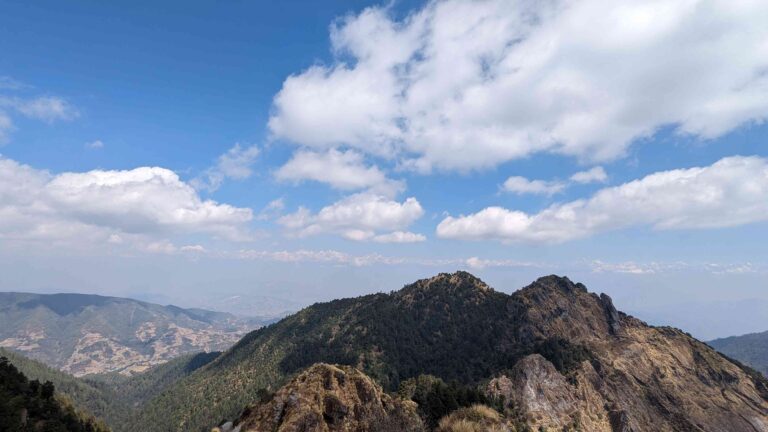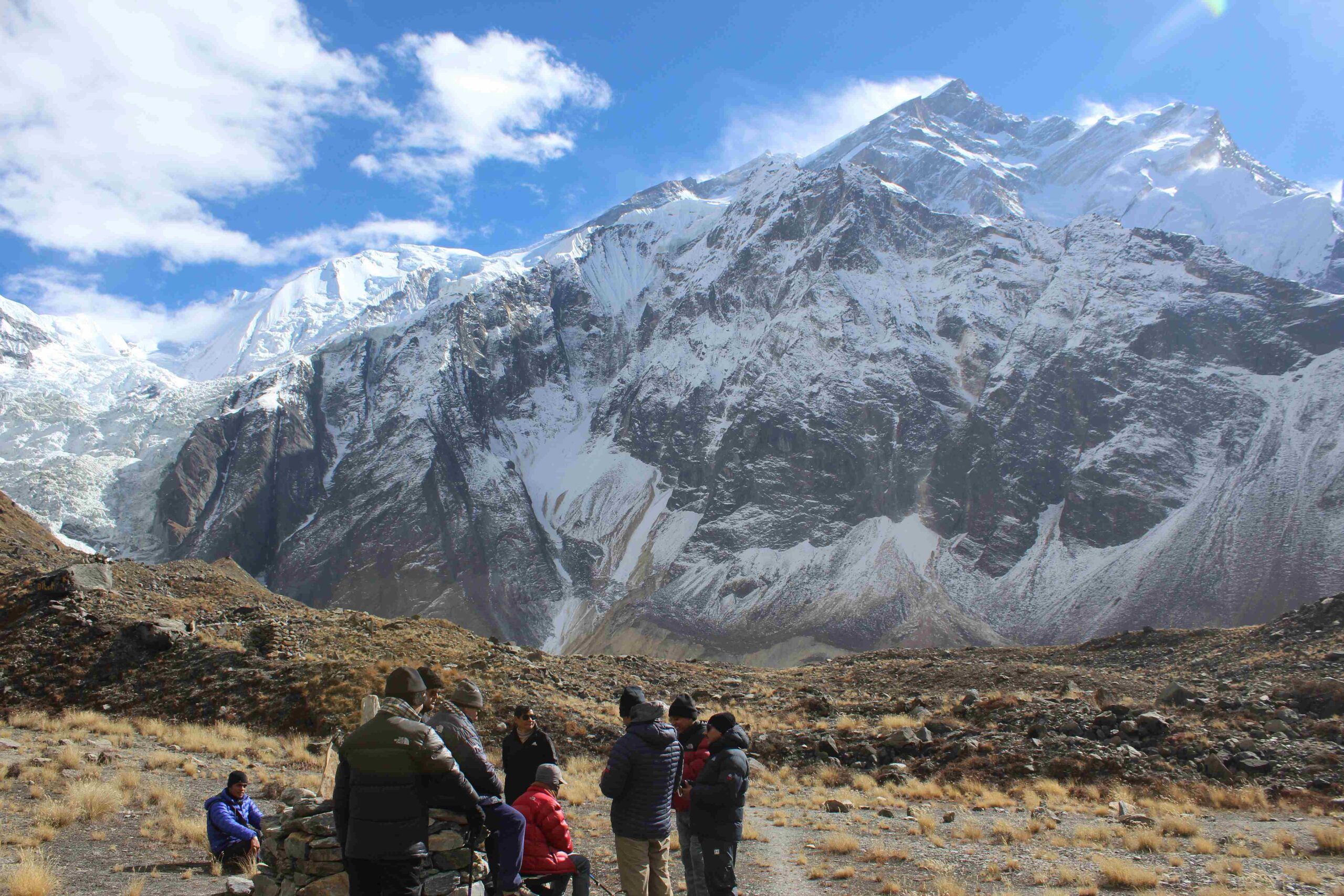At the crest of the Honku valley, at an elevation of 5,845 meters (19,177 feet), is the glaciated Amphu Lapcha Pass. The Amphu Lapcha Pass Trek, a glacier pass surrounded by serac cliffs, is one of the toughest treks in the Khumbu region. There are many days of walking involved in the trek, as well as preparation and experience at a high altitude. The famed Mera Peak Climbing is on route to the Amphu Lapcha Pass and passes through Seto Pokharu and Chhukung behinf=d Island Peak and in front of Ama Dablam. Hence, this trek offers a comprehensive view of the Khumbu region.
Several glacial lakes, notably the Panch Pokhri or Five Sacred Lakes, is at the base of the valley, which is at 5,000 meters (16,400 feet). On their way to Island Peak or Baruntse expeditions, mountaineers must navigate the technically challenging Amphu Labtsa pass. Lhotse Shar, Island Peak, and the Imja Glacier may all be seen clearly from the exposed ice and rock summit, which is also fairly exposed.
Details of Amphu Lapcha Pass Trek
| Name of the Trek | Amphu Lapcha Pass Trek |
| Trekking Region | Sagarmatha National Park, Everest and Khumbu Region |
| Trekking Difficulty | Strenuous; needs previous experience of trekking at high altitude |
| Number of Days | 20-22 days |
| Maximum Elevation | 5845 m |
| Accommodation | Homestay, tea houses at first and camping |
| Major Attractions | White bed of snow and glacier, view of Everest, Amadablam, Nuptse |
Highlights of Amphu Lapcha Trek
- Awe-inspiring panorama of the Himalayas, including Mount Everest (8,848m), Mount Ama Dablam (6,812m), Mount Nuptse (7,861m), Mount Lhotse (8,516m), and many others.
- Crossing the challenging but rewarding passes of Amphu Lapcha Pass (5,845m), Mera La Pass (5,350m) and Zatrwa La (4,600m).
- Being in and around the Sagarmatha National Park, it’s most hospitable as well as the most desolate regions.
- Exploring the most welcoming as well as most desolate regions in and around the Sagarmatha National Park.
Short Itinerary of Amphu Lapcha Pass Trek
| Day | Activity | Altitude | Time |
| Day 1 | Arrival at Kathmandu | 1400m | – |
| Day 2 | Explore Kathmandu Valley and Preparation | 1400m | – |
| Day 3 | Mountain Flight to Lukla, Trek to Chutanga | 3020m | 35 mins flight, 3 hours trek |
| Day 4 | Trek from Chutanga to Thulikharka | 4300m | 6 hours trek |
| Day 5 | Trek from Thulikharka to Thangnak | 4356m | 6 hours trek |
| Day 6 | Acclimatization at Thangnak | 4356m | – |
| Day 7 | Trek from Thangnak to Khare | 5045m | 5 hours trek |
| Day 8 | Trek from Khare to Kongme Dingma | 4850m | 7 hours trek |
| Day 9 | Trek from Kongme Dingma to Seto Pokhari | 5030m | 6 hours trek |
| Day 10 | Trek from Seto Pokhari to Amphu Lapcha South Base Camp | 5650m | 5 hours trek |
| Day 11 | Cross Amphu Lapcha Pass and Trek to Chhukung | 4750m | 7 hours trek |
| Day 12 | Trek from Chhukung to Tengboche | 3860m | 5 hours trek |
| Day 13 | Trek from Tengboche to Namche Bazaar | 3440m | 6 hours trek |
| Day 14 | Rest at Namche Bazaar | 3440m | – |
| Day 15 | Trek from Namche to Lukla | 2860m | 7 hours trek |
| Day 16 | Fly Back to Kathmandu | 1400m | 35 minutes mountain flight |
Detailed Itinerary of Amphu Lapcha Trek
Day 1: Arrival at Kathmandu
Once you arrive at Tribhuvan International Airport in Kathmandu, a shuttle will take you to the hotel of your choosing. You will discover additional details regarding the journey and the adventure. You can go to Thamel, the primary tourist attraction in Kathmandu, which has a vibrant nightlife.
Day 2: Explore Kathmandu Valley and Preparation
The day off is used for recuperation and exploration. The Kathmandu Valley is very diverse in terms of history and culture. There are 8 UNESCO Word Heritage Sites in the Kathmandu Valley. By visiting the historical palaces in Hanuman Dhoka Durbar Square, Patan Durbar Square, and Bhaktapur Durbar Square, you can admire the intricate architecture of the previous Malla dynasty. In the Kathmandu Valley, two of the most well-known religions in the world—Hinduism and Buddhism—converge to a singular summit. Travelers must visit the PashupatiNath temple, one of the biggest Hindu holy places. Similar to this, two of the most significant monasteries for Buddhists are Swambhunath (Monkey Temple) and Bouddhanath.
Day 3: Mountain Flight to Lukla, Trek to Chutanga
The 35-minute picturesque mountain flight from Kathmandu to Tenzing-Hillary Airport in Lukla marks the beginning of the expedition (2840 m). Lukla Airport is the one in Nepal with the greatest elevation. Your adventure to the Himalayas will start after registering for an access card at the Lukla Tourism Checkpoint.
You start from Lukla along the path that passes by the little farms. Your first day of trek ends at Chutunga, a tiny mountain settlement surrounded by rhododendron and pine trees.
Day 4: Trek to Thulikharka
You travel in the direction of Thulikharka by following the rocky trail that runs along the Kalo Himal Ridge (Nau Lakh). The Khumbu area and the HInku (Inkhu) Valley of Makalu region are divided by this ridge.
The Dudh Koshi River Valley, Karyolung Himal (6,511m), and Lumding Himal (6,111m) can all be seen from the top of Zartwa La Pass (Chhetra La Pass: 4,600m). To complete your quest for today, you finally make your way down to Thulikharka.
Day 5: Trek to Thangnak
As you travel through the Inkhu Valley, you may see Peak 43 (Kyashar Peak, 6,769 meters high), Kusum Kangaru, 6,367 meters high, and Mera Peak (6,474m) in the morning. You pass Gondishung and continue your journey to Thangnak. Thangnak is a tiny mountain settlement with a few stone houses that provide food and lodging for trekkers.
Day 6: Acclimatizatin at Thangnak
Today you rest and try to get accustomed to the high altitude, It is very necessary to acclimatize to body while trekking in the Himalayas.
Day 7: Trek to Khare
Trekking today will only require 4 to 5 hours and will be of a reasonably relaxed pace. You ascend towards the Charpate Tal, a small lake in a square shape. Moving towards Khare, you may admire Mera Peak‘s south face, one of Nepal’s well-known hiking peaks. You’ll establish a tent camp here and stay the night.
Day 8: Trek to Kongme Dingma
Because the trail today is a little more difficult, you start your journey as early as you can. The uphill and descending routes will get you to Kongme Dingma eventually. This location is dry and ideal for camping. It is the turning point for the Mera Peak trip that leads to Mera La Pass (5,350m).
Day 9: Trek to Seto Pokhari
You advance towards Seto Pokhari, which means “white pond,” by walking along the glacier moraine and steep terrain. The location of the tent camp will be close to the collection of five variously sized and shaped glacier lakes.
Day 10: Trek to Amphu Lapcha South Base Camp
You will ascend up the short, steep slope from Seto Pokhari. You will arrive at Amaphu Lapcha Base Camp South after navigating the ice river, glaciers, and moraine. To determine whether it is safe to climb across, it is necessary to check the weather.
Day 11: Cross the Amphu Lapcha Pass and Trek to Chhukung
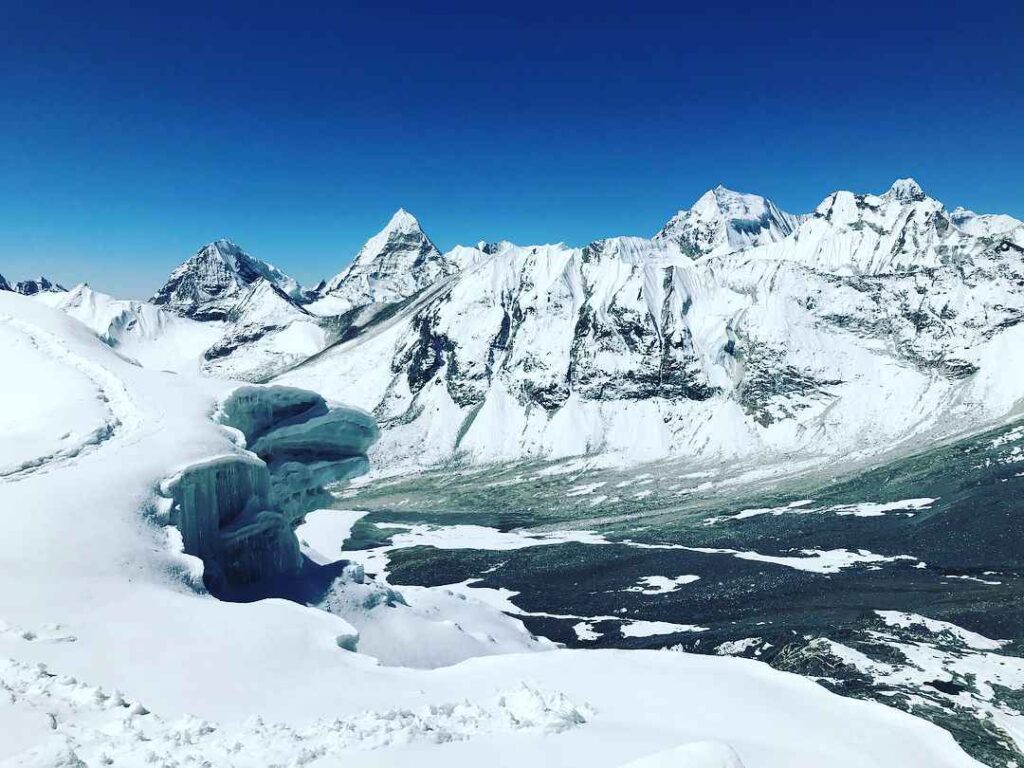
Today is the most challenging day of the entire trip to Amphu Lapcha Pass. After leaving the Hinku or Inkhu Valley, you will travel across the Amphu Lapcha Pass (5,845m) to arrive in the Chhukung Valley.
Awe-inspiring views of the Imja Tse Valley, the Inkhu Valley, and the surrounding snow-covered hills are visible from here. After admiring the stunning mountain scenery, you will use the ropes to descend. The trail leads to Chhukung at the end of the day after crossing Parsya Gyab close to the Imja Glacier and Island Peak Base Camp.
Day 12: Trek to Tengboche
You will progressively descend through Dingboche Village from Chhukung Village to Tengboche. Along the route, you’ll pass mountains including Mt. Ama Dablam (6,812 m), Mt. Nuptse (7,861 m), and Mt. Lhotse (8,516 m).
Finally, you arrive at Tengboche Village to wrap off your journey. You will see Tengboche Monastery here, which is the biggest monastery in the Khumbu region.
Day 13: Trek to Namche Bazaar
Following breakfast, you set out on your journey for the day. You reach Namche Bazar by traveling downwards along the rough trails that run alongside Sagarmatha National Park. It is also known as the Sherpa Capital since it is the major trading hub in the Everest region. This Himalayan town has all the contemporary conveniences one could want.
Day 14: Rest at Namche Bazaar
Namche is brimming with shops providing a wide range of items, cafes, bakeries, and both budget-friendly and opulent lodges. You could go to Hotel Everest View, a popular viewing location in the Everest region. From the hotel’s terrace, take in close-up views of Ama Dablam, Lhotse, Nuptse, Mount Everest, and Thamserku before visiting Khumjung, a famous Sherpa village.
Day 15: Trek to Lukla
You descend into Lukla while traversing the Sagarmatha National Park’s dense forests. As today would be your last day in the Everest region, try to make it as special as you can. Enjoy Sherpa cuisine and take a tour through the villages to learn more about their way of life, culture, and traditions.
Day 16: Fly Back to Kathmandu
Your trek ends here with a flight back to the capital city of Kathmandu.
How Difficult is Amphu Lapcha Trek?
The Amphu Lapcha Pass trek is difficult because it begins in the subtropical region and ascends to an elevation of more than 5000 meters. The trek is definitely not for beginner trekkers looking for something to plan for their first hike. Due to its technical requirements, prior trekking expertise is required. Additionally, it will be an advantage if you have experienced peak-climbing in Nepal.
Furthermore, the trek is challenging because it avoids a well-traveled route and instead leads to a region of desolate mountain passes and glaciers coated in snow and ice. As a result, it is undoubtedly one of the harshest natural settings one might be in, with temperatures that can plunge well below zero.
